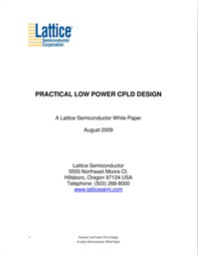PRACTICAL LOW POWER CPLD DESIGN
Any engineer involved with portable or handheld products knows that minimizing power consumption is an absolute requirement for today's designs. But only the veterans understand the subtle yet important details that can stretch a systems' battery life to the maximum.
In this white paper Lattice Semiconductor focusses on how those seasoned experts use ultra-low-power complex programmable logic devices (CPLDs) to wring out every last microwatt from the I/O subsystems of their embedded designs.
Download to find out more.
Read More
By submitting this form you agree to Lattice Semiconductor Corporation contacting you with marketing-related emails or by telephone. You may unsubscribe at any time. Lattice Semiconductor Corporation web sites and communications are subject to their Privacy Notice.
By requesting this resource you agree to our terms of use. All data is protected by our Privacy Notice. If you have any further questions please email dataprotection@techpublishhub.com
Related Categories: Batteries, Components, Displays, Embedded, Industrial, Power, Processors, Relays, Resistors, Switches

More resources from Lattice Semiconductor Corporation
ENABLING MOBILE INTERFACE BRIDGING IN ADAS AND INFOTAINMENT APPLICATIONS
In the automotive market as in all industries, competition breeds innovation. Over the last 100 years, this truth has transformed the horseless car...
Implementing Video Display Interfaces Using MachXO2 PLDs
Lattice Semiconductor has developed a display interface in the MachXO2 PLD family. Because this interface is now supported in MachXO2 devices, desi...
Flash Corruption: Software Bug or Supply Voltage Fault?
Flash memory is commonly used to store firmware in embedded systems. Occasionally, the firmware stored in the Flash memory in some systems is accid...
